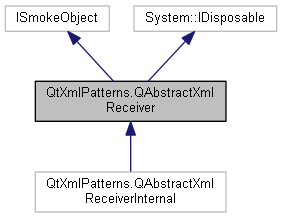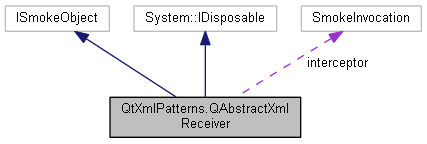|
Qyoto
4.0.5
Qyoto is a C# language binding for Qt
|
|
Qyoto
4.0.5
Qyoto is a C# language binding for Qt
|
The QAbstractXmlReceiver class provides a callback interface for transforming the output of a QXmlQuery. More...


Public Member Functions | |
| QAbstractXmlReceiver () | |
| | |
| virtual void | CreateProxy () |
| abstract void | AtomicValue (object value) |
| | |
| abstract void | Attribute (QXmlName name, QStringRef value) |
| | |
| abstract void | Characters (QStringRef value) |
| | |
| abstract void | Comment (string value) |
| | |
| abstract void | EndDocument () |
| | |
| abstract void | EndElement () |
| | |
| abstract void | EndOfSequence () |
| | |
| abstract void | NamespaceBinding (QXmlName name) |
| | |
| abstract void | ProcessingInstruction (QXmlName target, string value) |
| | |
| abstract void | StartDocument () |
| | |
| abstract void | StartElement (QXmlName name) |
| | |
| abstract void | StartOfSequence () |
| | |
| virtual void | WhitespaceOnly (QStringRef value) |
| new void | Dispose () |
Protected Member Functions | |
| QAbstractXmlReceiver (System.Type dummy) | |
Protected Attributes | |
| SmokeInvocation | interceptor |
Properties | |
| virtual System.IntPtr | SmokeObject [get, set] |
The QAbstractXmlReceiver class provides a callback interface for transforming the output of a QXmlQuery.
QAbstractXmlReceiver is an abstract base class that provides a callback interface for receiving an XQuery sequence, usually the output of an QXmlQuery, and transforming that sequence into a structure of your choosing, usually XML. Consider the example:
QXmlQuery query;
query.setQuery("doc('index.html')/html/body/p[1]");
QXmlSerializer serializer(query, myOutputDevice);
query.evaluateTo(&serializer);
First it constructs a query that gets the first paragraph from document index.html. Then it constructs an XML serializer with the query and myOutputDevice (Note the serializer is an XML receiver, ie a subclass of QAbstractXmlReceiver). Finally, it evaluates the query, producing an ordered sequence of calls to the serializer's callback functions. The sequence of callbacks transforms the query output to XML and writes it to myOutputDevice.
Although the example uses QXmlQuery to produce the sequence of callbacks to functions in QAbstractXmlReceiver, you can call the callback functions directly as long as your sequence of calls represents a valid XQuery sequence.
XQuery Sequences
An XQuery sequence is an ordered collection of zero, one, or many items. Each item is either an atomic value or a node. An atomic value is a simple data value.
There are six kinds of nodes.
An Element Node represents an XML element.
An Attribute Node represents an XML attribute.
A Document Node represents an entire XML document.
A Text Node represents character data (element content).
A Processing Instruction Node represents an XML processing instruction, which is used in an XML document to tell the application reading the document to perform some action. A typical example is to use a processing instruction to tell the application to use a particular XSLT stylesheet to display the document.
And a Comment node represents an XML comment.
The sequence of nodes and atomic values obeys the following rules. Note that Namespace Node refers to a special Attribute Node with name xmlns.
Each node appears in the sequence before its children and their descendants appear.
A node's descendants appear in the sequence before any of its siblings appear.
A Document Node represents an entire document. Zero or more Document Nodes can appear in a sequence, but they can only be top level items (i.e., a Document Node can't be a child of another node.
Namespace Nodes immediately follow the Element Node with which they are associated.
Attribute Nodes immediately follow the Namespace Nodes of the element with which they are associated, or...
If there are no Namespace Nodes following an element, then the Attribute Nodes immediately follow the element.
An atomic value can only appear as a top level item, i.e., it can't appear as a child of a node.
Processing Instruction Nodes do not have children, and their parent is either a Document Node or an Element Node.
Comment Nodes do not have children, and their parent is either a Document Node or an Element Node.
The sequence of nodes and atomic values is sent to an QAbstractXmlReceiver (QXmlSerializer in the example above) as a sequence of calls to the receiver's callback functions. The mapping of callback functions to sequence items is as follows.
startDocument() and endDocument() are called for each Document Node in the sequence. endDocument() is not called until all the Document Node's children have appeared in the sequence.
startElement() and endElement() are called for each Element Node. endElement() is not called until all the Element Node's children have appeared in the sequence.
attribute() is called for each Attribute Node.
comment() is called for each Comment Node.
characters() is called for each Text Node.
processingInstruction() is called for each Processing Instruction Node.
namespaceBinding() is called for each Namespace Node.
atomicValue() is called for each atomic value.
For a complete explanation of XQuery sequences, visit XQuery Data Model.
See also W3C XQuery 1.0 and XPath 2.0 Data Model (XDM), QXmlSerializer, and QXmlResultItems.
|
protected |
| QtXmlPatterns.QAbstractXmlReceiver.QAbstractXmlReceiver | ( | ) |
Constructs an abstract xml receiver.
|
pure virtual |
This callback is called when an atomic value appears in the sequence. The value is a simple data value. It is guaranteed to be valid.
|
pure virtual |
This callback is called when an attribute node appears in the sequence. name is the attribute name and the value string contains the attribute value.
|
pure virtual |
This callback is called when a text node appears in the sequence. The value contains the text. Adjacent text nodes may not occur in the sequence, i.e., this callback must not be called twice in a row.
|
pure virtual |
This callback is called when a comment node appears in the sequence. The value is the comment text, which must not contain the string "–".
|
virtual |
| new void QtXmlPatterns.QAbstractXmlReceiver.Dispose | ( | ) |
|
pure virtual |
This callback is called when the end of a document node appears in the sequence.
|
pure virtual |
This callback is called when the end of an element node appears in the sequence.
|
pure virtual |
This callback is called once only, right after the sequence ends.
|
pure virtual |
This callback is called when a namespace binding is in scope of an element. A namespace is defined by a URI. In the QXmlName name, the value of QXmlName::namespaceUri() is that URI. The value of QXmlName::prefix() is the prefix that the URI is bound to. The local name is insignificant and can be an arbitrary value.
|
pure virtual |
This callback is called when a processing instruction appears in the sequence. A processing instruction is used in an XML document to tell the application reading the document to perform some action. A typical example is to use a processing instruction to tell the application to use a particular XSLT stylesheet to process the document.
<?xml-stylesheet type="test/xsl" href="formatter.xsl"?>
target is the name of the processing instruction. Its prefix and namespace URI must both be empty. Its local name is the target. In the above example, the name is xml-stylesheet.
The value specifies the action to be taken. Note that the value must not contain the string "?>". In the above example, the value is type="test/xsl" href="formatter.xsl.
Generally, use of processing instructions should be avoided, because they are not namespace aware and in many contexts are stripped out anyway. Processing instructions can often be replaced with elements from a custom namespace.
|
pure virtual |
This callback is called when a document node appears in the sequence.
|
pure virtual |
This callback is called when a new element node appears in the sequence. name is the valid name of the node element.
|
pure virtual |
This callback is called once only, right before the sequence begins.
|
virtual |
|
protected |
|
getset |